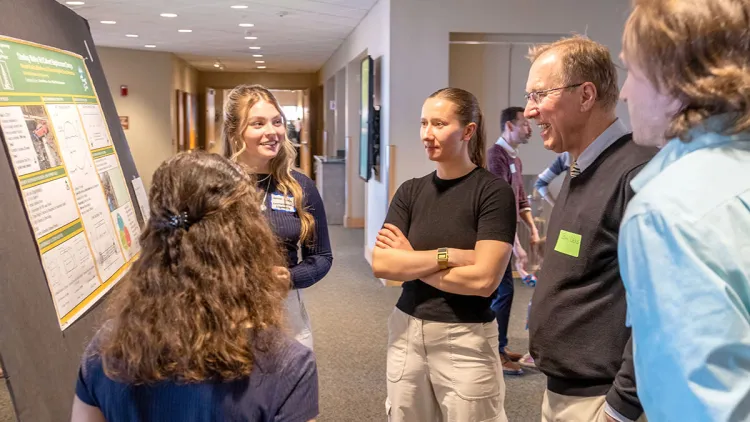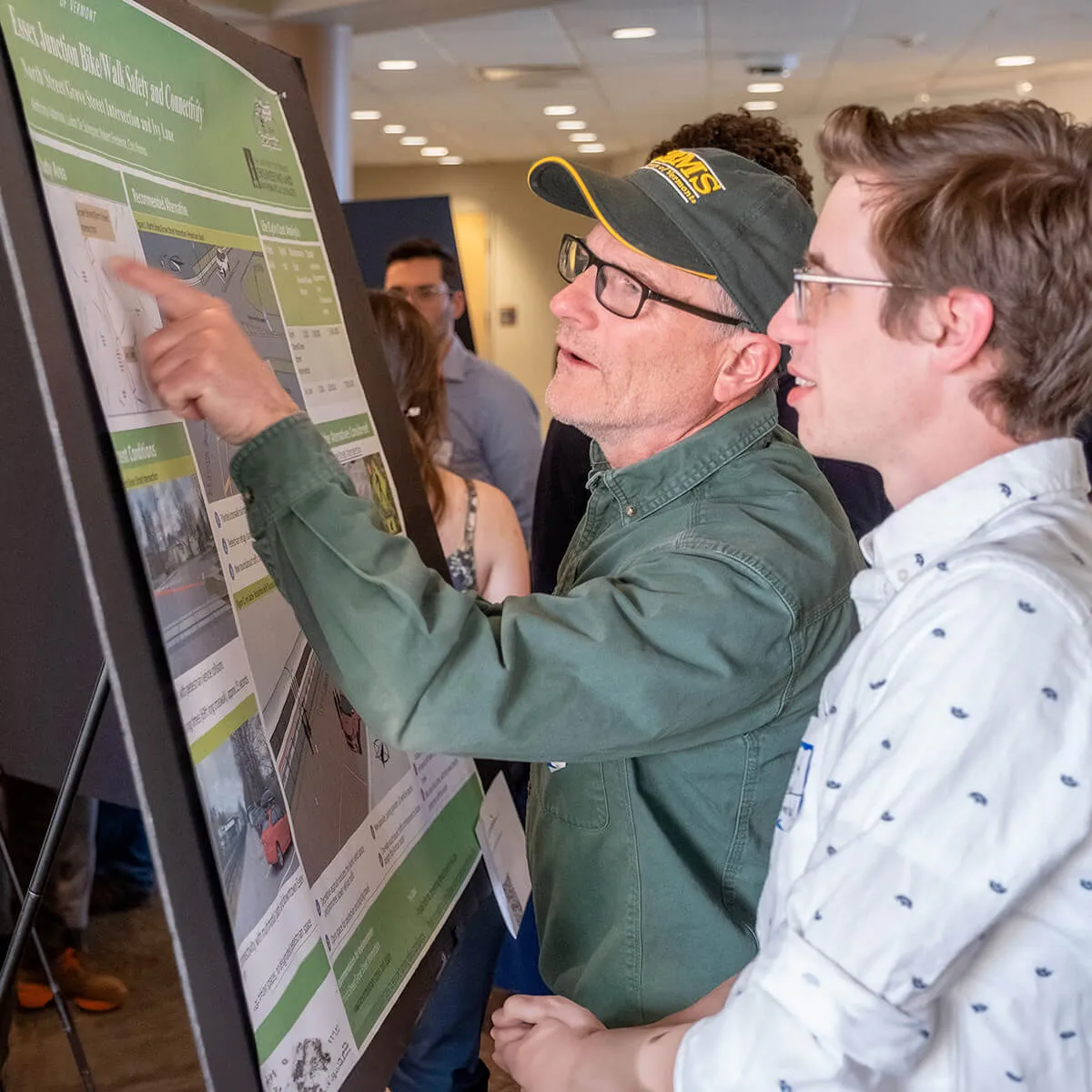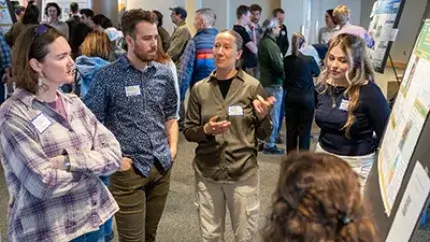
Our Civil Engineering and Environmental Engineering graduates have a significant capstone senior design experience in their final year. Currently, it is an intense semester-long experience on projects submitted by local, state, and federal agencies, municipalities, non-profits, engineering design competitions, or UVM Staff and Faculty. Most projects are service-learning with community partners sharing their real-life experiences of sustainably meeting diverse community needs with limited resources. Students investigate the client’s needs and create an engineering design that best solves the client’s problem or unmet need, considering the constraints and resources affecting the solution’s sustainability.
We select projects that offer a solid design experience and at the same time promote sustainability and civic engagement. For each project, students consider multiple design alternatives and suggest recommendations based on costs and social and environmental impacts. They write comprehensive technical reports and make presentations to external evaluators, faculty, fellow students, and community partners.
Fall 2025 Capstone Project Design and Poster Review Schedule
Design Review Sessions
| # | Project | Description | Project Location | Presentation Day | Presentation Time | Presentation Location* |
|---|---|---|---|---|---|---|
| 1 | Centennial Woods Bridge | Design repair/replacement for a damaged pathway bridge over Centennial Brook | Burlington | Friday 12/5/25 | 3:30-4:00 | UVM Votey Hall Room 209 |
| 2 | Plainfield Culvert | Design repair/replacement for an undersized culvert on Gore Road | Plainfield | Monday 12/1/25 | 3:30-4:00 | UVM Votey Hall Room 209 |
| 3 | Shelburne Cemetery Stormwater | Design stormwater runoff mitigation for phosphorous mitigation | Shelburne | Monday 12/1/25 | 5:00-5:30 | UVM Votey Hall Room 209 |
| 4 | Drinking Water Supply Augmentation | Design village water supply capacity improvements | Jeffersonville | Wednesday 12/3/25 | 5:00-5:30 | UVM Votey Hall Room 209 |
| 5 | Highland Avenue Sewer | Design repair/replacement for deteriorating village sanitary sewers | Stowe | Monday 12/1/25 | 4:30-5:00 | UVM Votey Hall Room 209 |
| 6 | Montpelier Ice Jam Flooding Mitigation | Design ice jam hazard mitigation for the Winooski River in Montpelier | Montpelier | Wednesday 12/3/25 | 4:00-4:30 | UVM Votey Hall Room 209 |
| 7 | Warren Garage Site Reuse | Design garage and sand storage site reuse options for community benefit | Warren | Wednesday 12/3/25 | 5:30-6:00 | UVM Votey Hall Room 209 |
| 8 | Culvert Plugging Mitigation | Design measures to prevent small culvert plugging from boulders in extreme streamflows | Stowe | Monday 12/1/25 | 4:00-4:30 | UVM Votey Hall Room 209 |
| 9 | Depot Street Bridge | Design repair/replacement for an 86 year old steel/concrete bridge | Jamaica | Monday 12/1/25 | 5:30-6:00 | UVM Votey Hall Room 209 |
| 10 | Routes 5 and 121 Intersection | Design pedestrian and traffic safety improvements | Bellows Falls | Friday 12/5/25 | 4:00-4:30 | UVM Votey Hall Room 209 |
| 11 | Route 7 Shelburne Village Intersection | Design pedestrian and traffic safety improvements | Shelburne | Wednesday 12/3/25 | 3:30-4:00 | UVM Votey Hall Room 209 |
| 12 | GMT Transit Stop Design | Design ADA accessible transit stops | Chittenden County | Wednesday 12/3/25 | 4:30-5:00 | UVM Votey Hall Room 209 |
Capstone Presentations Remote Meeting LinkDesign Night Poster Session
| Presentation Day | Presentation Time | Presentation Location* |
|---|---|---|
| Monday 12/8/25 | 4:30-7:30 | Innovation Hall, Room E210 |
Download a PDF version of the Fall 2025 Design and Poster Review Schedule
Parking Passes
Frequently Asked Questions
What is CEnvE Capstone?
Seniors work in teams over a semester to address complex and multidisciplinary problems given to them by a client. Projects originate as problem or needs statements submitted by local, state, and federal agencies, municipalities, non-profits, engineering design competitions, or UVM Staff and Faculty. Students investigate the client’s needs and create an engineering design that solves the client’s problem or unmet need.
Why Sponsor a CEnvE Project?
There are many reasons to sponsor a project and participate in CEnvE, depending on your perspective:
Governmental organizations:
- CEnvE projects offer the opportunity to work directly with senior level students who will soon enter the engineering workforce.
- The organization gets to take a long-standing problem off the back burner with minimal effort from existing staff.
- The organization can explore a new idea or concept only needing limited existing staff resources to investigate and develop.
- Engineers and scientists in these organizations usually consider the project interaction with students a welcome addition to their more typical duties.
Non-Governmental organizations or Non-Profits:
- CEnvE projects offer the opportunity to solve a problem for your organization that you may not be able to afford using traditional engineering resources.
- The organization can evaluate a new idea or concept they don’t currently have the skills to investigate, engineer, and design.
Staff and Faculty:
- CEnvE projects offer an opportunity to work with small groups of undergraduate students who share a passion for your area of research.
- The students can advance engineering related design or research toward an outcome to be described in a well-defined project investigation report.
Engineering Design Competition Sponsors:
- Support innovation in an area of interest and need.
- The competition creates an opportunity and motivation for advancing a special initiative via a defined project goal over the course of a semester or more.
How do I submit projects for consideration?
To discuss a project idea, contact the CEnvE program instructor, John Lens, via John.Lens@uvm.edu
What is the process to get a project accepted?
The course instructor will work with you to establish a project scope, schedule, and desired outcomes/deliverables appropriate for the course and students’ skill level. Once these are mutually agreed upon, you and the course instructor create a project Letter of Understanding (LOU). The LOU agreement outlines the expectations of both you as the client and the student team for the duration of the course. At this point, the project awaits selection by students. At the beginning of each semester, the projects are presented to the students who rank the projects in their order of interest. The instructor assigns students to projects, based on students’ interests, background, and applicable skills. If your project has enough interest, it will become active and the student team will start working on your project. We cannot guarantee that all projects will move forward, but most do.
What are clients' responsibilities?
The client agrees to assign a liaison to the project who will attend a CEnvE project kickoff meeting with the student team. The liaison is required to regularly communicate with the students and promptly supply information to students when needed. The client liaison needs to review and approve the students’ proposed scope, deliverables, and schedule proposal and support communication between the UVM students and the client. The liaison needs to review two design reports (mid-semester and final) to confirm the student work meets the client’s needs and provide constructive feedback on clarity of the explanations.
We ask clients to recognize these are students who are learning the engineering design process. They are asked to meet the needs of both the client and the course, which do not always align perfectly. We appreciate your willingness to allow for some flexibility in this process, making the learning process as rich as possible.
What does sponsoring a CEnvE capstone project cost the sponsor?
There is no formal fee structure. We welcome sponsorship funding from clients, on a voluntary basis, such as to help reimburse students’ travel expenses to project sites and costs of project-specific consumables. We recognize that sponsorship funding is not possible for some clients and appreciate that their time spent interacting with the students is a valuable non-monetary form of sponsorship.
What happens during the semester?
During the semester, students will:
Investigate to understand the client’s and stakeholder needs.
Investigate existing standards of practice and new developments in practice.
Obtain background information, relevant field and lab data, and prepare a background/data/needs memo.
Finalize their scope of work, deliverables, and schedule for client review and approval.
Make an Interim (mid-semester) Design Review presentation to the client to review alternatives and obtain client feedback.
Continue engineering to expand upon the chosen final design concept.
Prepare a Final Report with design drawings, a cost estimate, and confirming the design complies with permitting requirements.
Present the project in a Final Design Review session to the client, outside reviewers, faculty, and students at the end of the semester.

Senior Capstone Projects in CEMS
The CEMS educational journey for many of our engineering students culminates in a senior capstone project where seniors have the opportunity to apply their education and engage in hands-on engineering and real-world challenges.
Senior Capstone Projects in CEMSSome Past Projects
General Stannard House Restoration
General Stannard House Restoration
Community Partner: Milton Historical Society
Participating students: Ryan Bailey, Jack Dugdale, Zachary Ferguson, Timothy Sayler, Nora Varhue
Williston Green Streets
Williston Green Streets: Mitigating Roadway Ponding via Rain Gardens and Infiltration Trenches
Community Partner: Town of Williston, VT
Participating students: Olivia Lincoln, Nate Robeson, Tyler Fish, Patrick Flaherty, Scott Goodwin
CSWD Anaerobic Sludge Digestion
CSWD Anaerobic Sludge Digestion
Community Partner: Chittenden Solid Waste District
Participating students: Wesley Miller, Kevin Nguyen, Ben Rukavina, Flora Su, Alexandra White
Essex Junction Multi-use Path & Bridge
Village of Essex Junction, Vermont: Essex Junction Educational Drive Intersection and Vermont Route 15 Multi-use Path and Bridge
Community Partner: Village of Essex Junction, VT
Participating students: Jace Curtis, David Gagnon, Anna Nadler, Benjamin Rouleau, Timur Steis
Gasification Treatment of Wastewater Sludge
Gasification Treatment of Wastewater Sludge for Chittenden County Solid Waste District
Community Partner: Chittenden County Solid Waste District (CSWD)
Participating students: Kyle Andrews, Luke Detwiler, Karin Emanualson, Emma Raeside, Erik Soderstrom
CEnvE Capstone Program Instructor
Senior Lecturer - Professor of Practice, Department of Civil and Environmental Engineering
John.Lens@uvm.edu
